Why Tariffs Are a Tough Argument to Make
Dr. Peter Linneman's take on pricing and inflation impacts.

Since tariff-mania began, we have been repeatedly asked: “Are tariffs good for the economy?” The answer is: “Of course not” (except in some national defense scenarios). Simply stated, tariffs are just taxes.

And research on every known tax shows that higher taxes reduce growth. This is true of income taxes, estate taxes, capital gains taxes, corporate profit taxes, tariffs, VATs, etc. This is because taxes reduce and distort incentives. They are a necessary evil to support government activities, but make no mistake, taxes reduce growth. And the larger and more extensive the tax, the larger this economic damage.
The only good argument for tariffs is that they protect key industry facilities, particularly in situations of national security, such as a major pandemic or a war. But these benefits are difficult to quantify and easy to proclaim.
U.S. imports total about $3 trillion, while GDP is $30 trillion. So, an average import tariff of 20 percent (vs. 3 percent for the past six years) represents $600 billion in potential tariff-driven tax revenues (assuming no drop in imports). This is on a $2.1 trillion federal deficit. Hence President Donald Trump’s attempt to reduce the budget deficits via “big, beautiful” tariffs. But the reality is that tariff revenues will fall far short of this number, due to a certain decline in imports.
The ever-changing tariff proposals of the Trump administration represent up to a 1,700-basis-point increase in the tax on roughly 10 percent of the economy. That is a large tax increase on a fairly broad part of the economy. An additional concern, particularly in April, was the unnecessary uncertainty caused by Trump’s chaotic tariff reversals. The uncertainty about the exact extent of the tax increases has caused some businesses and consumers to “pause.” However, acknowledgement of the so-called TACO (Trump Always Chickens Out) trade appears to have muted the extreme reactive stock market swings.
The only good argument for tariffs is that they protect key industry facilities, particularly in situations of national security, such as a major pandemic or a war.
We’d also be facing huge tax uncertainty (relating to increases on personal, corporate, capital gains and estate taxes) and attendant negative effects on growth, had the Democrats won. The real tragedy is that the Trump administration could have avoided any tax increases and simply focused on eliminating wasteful federal spending.
Based on the best (nonpolitically driven) analysis we have found, an increase in the average tariff from the 2024 level of about $3 per $100 of imports to $20 per $100 of imports would reduce GDP growth by 150 to 200 basis points per year. While a few will gain, most will suffer from higher tariffs. U.S. real GDP growth will fall 0.75 to 1 percent if the average tariff rises to $20 per $100 of imported goods. But as this estimate is a linear extrapolation well beyond the range of the data analyzed, the prediction error is high. The actual impact will be much less as people adjust, though in the short term it will be serious sand in the gears of the economy.
The impact of tariffs on price levels and inflation will be nuanced. Research suggests that about 65 percent of the 17-percentage-point average tariff increase will be passed on in the form of higher prices of imported goods. This will raise average prices in the first instance by about 110 basis points (a 17 percent cost increase, of which 65 percent is passed on for 10 percent of the economy). But thereafter, it will have no inflationary impact, as inflation is about the rate of change in prices, not their level. So, if inflation would have been 2 percent without the rise in tariffs, it would jump to 3 percent because of higher tariffs before falling back to 2 percent. This indicates that the ongoing adverse impact on GDP is a far more substantial concern than the impact on inflation.
They are a necessary evil to support government activities, but make no mistake, taxes reduce growth.
It is important to remember that just as people adjust and come in from a downpour, so, too, people will adjust to higher tariffs over time. These changes will lower the average tariff paid and shrink imports, lowering the impact on tax revenues, real GDP and prices over time. We suspect these impacts will be about half of the numbers discussed above after two to three years.
One last consideration on tariffs is worth noting. As we researched tariffs around the world prior to the Trump announcement, we were frankly surprised at how high average tariffs were in a supposedly free trade world. For example, it was 5 percent in the EU. So much for the unfettered flow of goods and services around the globe. It is possible that Trump is fighting a border skirmish to win a war. That is, to enhance free trade, he is raising trade barriers—fighting fire with fire. But this is a very dangerous strategy, as border conflicts can quickly escalate into all-out war.
But if raising tariffs leads to most countries (including the U.S.) reducing tariffs and trade restrictions, it will be a big economic victory. As of mid-June, the only major trade deal struck by the administration thus far was with China. The announced agreement freezes the tariff on Chinese imports to the U.S. at 55 percent, while China imposes a 10 percent tariff on U.S. imports to China. The deal also provides rare earth mineral supplies and preserves student exchanges. Watch what happens in Vietnam, the Philippines, Thailand and Malaysia, as these are “back doors” for high tariffs on China. In the end, we expect the average tariff to rise from about $3 per $100 to about $5 per $100 of imports. This 2 percent increase on 10 percent of the economy will needlessly reduce GDP, but by a minimal amount.
Dr. Peter Linneman is a principal & founder of Linneman Associates (www.linnemanassociates.com), professor emeritus at the Wharton School of Business, University of Pennsylvania, author of “Real Estate Finance and Investments: Risks and Opportunities,” and co-author of “The Great Age Reboot: Cracking the Longevity Code for a Longer Tomorrow.” Follow Dr. Linneman on X: @P_Linneman








You must be logged in to post a comment.